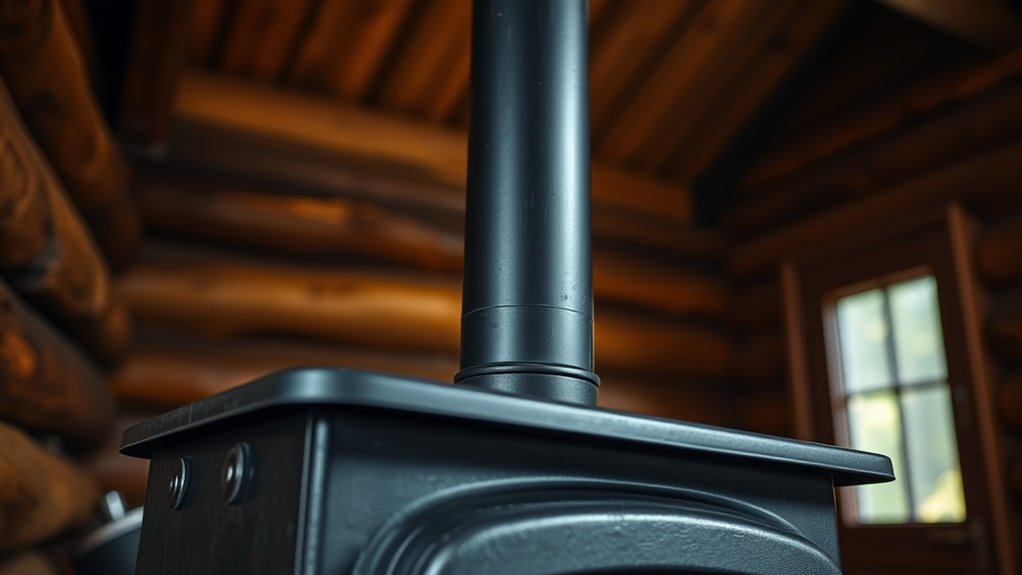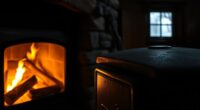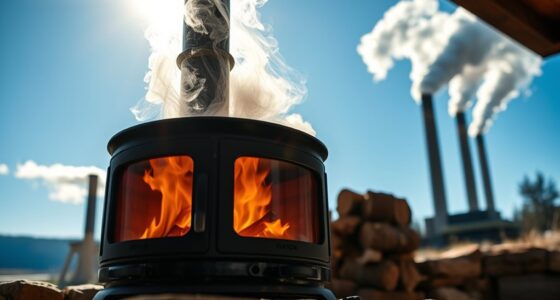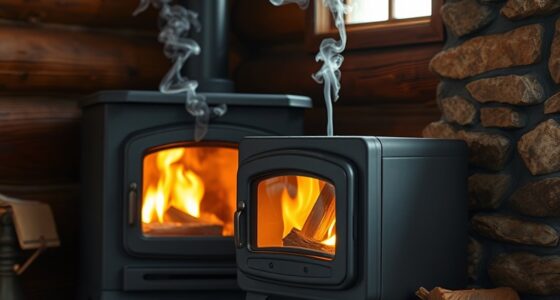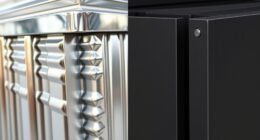For small wood stoves, you’ll need to make certain your chimney extends at least 3 feet above your roofline. It should also be at least 2 feet higher than any structure within a 10-foot radius to promote proper draft and safe venting. Proper height helps prevent smoke and carbon monoxide from entering your home while improving stove efficiency. Understanding these requirements is key to safe and effective heating — keep exploring to learn more about ideal chimney setup.
Key Takeaways
- Small wood stoves typically require a chimney extending at least 3 feet above the roofline.
- The chimney must be at least 2 feet higher than any nearby structure within 10 feet.
- Proper height ensures safe draft and prevents smoke or carbon monoxide entering living spaces.
- Local building codes may specify specific minimum chimney heights for small stoves.
- Taller chimneys in windy areas help prevent downdrafts and improve venting efficiency.
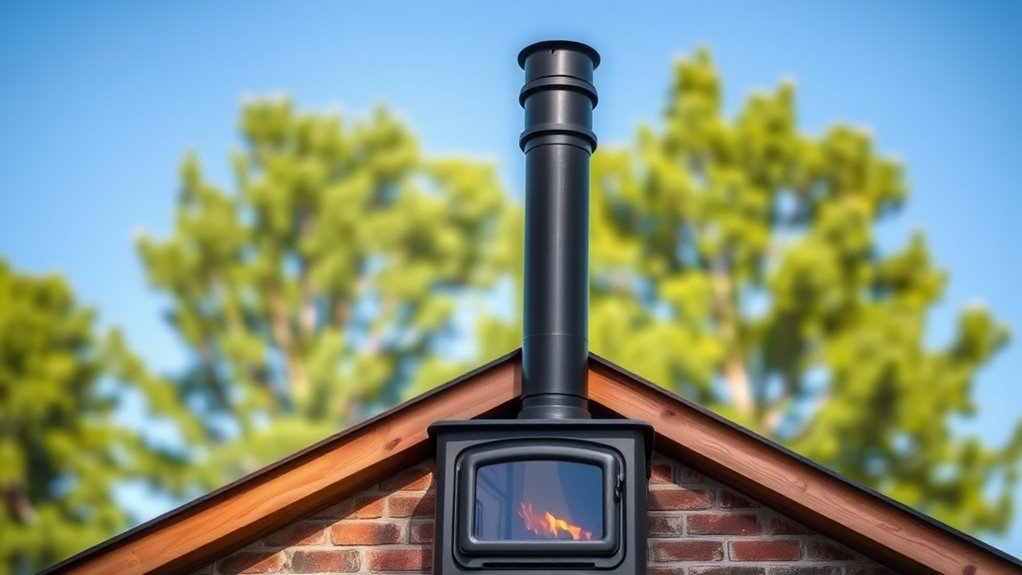
When installing a small wood stove, ensuring the chimney height is correct is essential for safe and efficient operation. Proper chimney height directly impacts venting requirements and helps meet safety standards, preventing dangerous smoke or carbon monoxide from entering your living space. You need to understand that venting requirements aren’t just about fitting a pipe; they’re about creating a safe, effective draft that pulls smoke and gases out of your home without backdrafting or leaks. If the chimney is too short, it may not generate enough draft, causing smoke to spill into the room or reducing the stove’s efficiency. Conversely, an excessively tall chimney can be unnecessarily costly and may create issues with wind and downdrafts, which also compromise venting.
Most local building codes and safety standards specify a minimum chimney height that generally involves extending the chimney at least 3 feet above the roofline or at least 2 feet higher than any structure within a 10-foot radius. These standards aren’t arbitrary; they’re designed to optimize venting and prevent downdrafts, which occur when wind pushes smoke back into the home. When you’re installing your stove, you should verify these regulations, as failing to meet them can lead to safety violations or insurance issues. A properly designed chimney height ensures the smoke rises, dispersing safely into the atmosphere, reducing the risk of carbon monoxide buildup inside your home. Additionally, understanding chimney design considerations can help you achieve better performance and safety, especially in varying weather conditions.
The key is maintaining a height that promotes safe venting while adhering to safety standards. Your goal is to achieve consistent draft and prevent smoke spillage, which could be hazardous. If you’re in a windy area, you might need a taller chimney to mitigate downdrafts, whereas in calmer regions, the standard minimum height could suffice. Remember, the correct chimney height is also influenced by the local climate and topography, which can affect how wind interacts with your structure. A well-vented stove operates better, produces less creosote buildup, and burns cleaner, prolonging its lifespan.
Ultimately, you want your chimney to be high enough to ensure safe venting, meet safety standards, and optimize your stove’s performance. Don’t cut corners by installing a shorter chimney just to save money, because the risks—like smoke infiltration or carbon monoxide poisoning—are far more costly. Take the time to carefully plan your chimney height, consulting local codes and manufacturer recommendations, so you can enjoy a safe, efficient, and cozy heating experience with your small wood stove. Proper chimney height is a crucial factor in achieving optimal stove operation and safety.
Frequently Asked Questions
Can I Install a Chimney Lower Than Recommended for Safety?
You shouldn’t install a chimney lower than the recommended height because it can compromise chimney clearance and affect draft performance. A lower chimney may lead to poor airflow, causing smoke and dangerous fumes to escape into your home. Always follow the manufacturer’s guidelines and local codes to guarantee safety and ideal performance. Proper chimney height maintains adequate clearance and improves draft, keeping your wood stove safe and efficient.
Do Local Building Codes Affect Chimney Height Requirements?
Think of local building codes as the heartbeat of your home’s safety rhythm. Yes, local regulations do impact chimney height requirements, ensuring your stove’s venting system reaches for the sky safely. You must follow code compliance to prevent smoke or dangerous gases from lingering. Ignoring these rules is like trying to tame a wildfire with a water pistol—ineffective and risky. Always check with local authorities before installing your chimney.
How Does Chimney Height Impact Stove Efficiency?
Chimney height directly affects your stove’s efficiency by improving draft height and smoke draw. A taller chimney creates better airflow, helping smoke exit smoothly and reducing creosote buildup. If the chimney’s too short, draft height decreases, causing poor combustion and increased emissions. To optimize your small wood stove’s performance, guarantee your chimney is tall enough to promote strong draft height and effective smoke draw, keeping your stove burning efficiently.
Is a Taller Chimney Better for Small Wood Stoves?
A taller chimney is generally better for small wood stoves because it improves chimney clearance and draft stability. When you extend the chimney height, you help prevent downdrafts and make certain of better airflow, which increases efficiency. While you shouldn’t go excessively high, a chimney that’s tall enough to clear nearby structures guarantees ideal draft. This setup reduces smoke issues and promotes safer, more efficient burning.
What Are the Consequences of Inadequate Chimney Height?
If your chimney isn’t tall enough, you’ll face poor chimney draft and smoke spillage, risking health hazards and stubborn odors. Without adequate height, your stove struggles to vent properly, causing inefficient heating and potential smoke leaks into your home. This not only damages your indoor air quality but also creates safety concerns. Ensuring proper chimney height keeps your stove functioning safely and efficiently, giving you peace of mind.
Conclusion
So, now you know that the right chimney height for your small wood stove depends on local codes and your home’s specifics. Remember, a taller chimney helps improve airflow and reduces smoke buildup. Are you ready to install a chimney that keeps your home warm and safe? Don’t overlook these details—your comfort and safety are worth it. With the right height, you’ll enjoy cozy fires and peace of mind all winter long.

